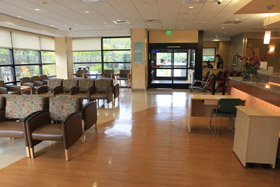Santa Rosa Memorial Hospital’s updated and expanded emergency department
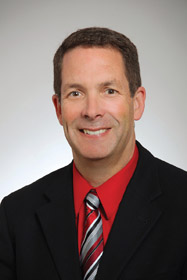 “It’s like rebuilding an airplane in mid-flight with 300 passengers on board.” Famous for his analogies, this is how Gary McCalla, M.D., former medical director for the Emergency Department at Santa Rosa Memorial Hospital (SRMH), explains the process of renovating while still attending to patients, trauma situations and the many everyday responsibilities of running a Level II regional trauma center. In short, the two-year process wasn’t always easy and affected patients, families and, especially staff. But it was also well worth the wait and has resulted in a new state-of-the-art facility that will benefit not only the immediate community, but also the entire five-county area it serves.
“It’s like rebuilding an airplane in mid-flight with 300 passengers on board.” Famous for his analogies, this is how Gary McCalla, M.D., former medical director for the Emergency Department at Santa Rosa Memorial Hospital (SRMH), explains the process of renovating while still attending to patients, trauma situations and the many everyday responsibilities of running a Level II regional trauma center. In short, the two-year process wasn’t always easy and affected patients, families and, especially staff. But it was also well worth the wait and has resulted in a new state-of-the-art facility that will benefit not only the immediate community, but also the entire five-county area it serves.“The biggest challenge was continuing to work in the same environment as the construction,” says McCalla, who still practices emergency medicine at the hospital while also acting as chief medical officer for REACH Air Medical Services. “For two years, you’d come to work and everything was frequently different. Literally, you’d go home one day and you’d come back the next and everything had been moved six beds down and there were now sheets of plastic up, dividing things.”
Using another one of his analogies, McCalla counseled his nurses and physicians group to expect the experience to be like taking a two-year backpacking trip: “We’re going to find a place to sleep every night,” McCalla told his staff. “We’re going to find water and food. It may be a little lumpy and bumpy sometimes, and, other times, it might be fine. But we’re not going to be in the same place every night for the next two years; things are going to be constantly different. But, at the end, we’ll have a new place to live.”
While patients and family members may not have noticed too much (an average length of stay for an emergency department visit is less than four hours), the constant change and noise of jack hammering, power drilling and other commotion normal to a construction zone was especially hard on staff.
“Every time something changed, people had to readjust,” says McCalla. “The first time I worked in one of the new areas, I literally had to draw a map of where the new rooms were, because I’d go to see a patient and wouldn’t even know where I was going!”
Well worth the wait
What may have caused a lot of headache and frustration for more than two years concluded with a much needed, expanded facility that officially opened August 4, 2014. The 4,228-square-foot expansion enlarged the emergency department from 19 bays to 26 fully enclosed, walled-off, private rooms, allowing a 50 percent increase in space for patient care that now totals 13,500 square feet. This will ensure more personalized, private care and comfort for patients and their families, and the expanded space will help reduce patient wait times.
“Everything we do has the underlying goal of producing not just good patient care but excellent patient care,” explains Dr. Kendall Allred, current medical director of the Emergency Department at SRMH. “We want the patients, from the minute they arrive and through the whole process, to feel safe and cared for. It’s a very anxiety-provoking situation to come to the ER. Having private rooms where you can close the door and it can be quiet while you conduct your interview with the patient without having all this ancillary noise, and having space for their family to be in the room, is a big benefit. I think our patients appreciate that.”
Other new features, designed by Los Angeles-based RBB Architects, Inc., and overseen by Wright Contracting of Santa Rosa, the project’s general contractor, include enlarged, upgraded suites just off the ambulance entrance for rapid treatment of trauma and heart attack patients. A sunlit, enlarged waiting area with seating for 60 people and a roomier registration/reception area was also added, as well as additional private space for consultations with patient families and a furnished, outdoor patio and garden—an extension of the waiting area for patients and families.
Operations within the department have also been streamlined to maximize space and increase efficiency, thereby expediting care. For example, each private patient room has been standardized, eliminating the need to search for or wait for a piece of equipment. Patients will appreciate this effort to lessen their wait time in the ER.
“One of the things we really focused on is having something we call the ‘standard patient room setup,’” explains Allred. “Every room has the same supplies, patient monitor and large exam light. For the patient, nurse and the physician, it makes it really easy because you don’t have to go looking for something that’s in another room.”
Ready for anything
There are several reasons this renovation and expansion of the emergency department was necessary—even vital—to the hospital and the community-at-large. A primary reason was that the hospital simply needed more space, given it’s the region’s only Level II trauma center, not only for Sonoma County, but for the surrounding coastal valleys area, including Sonoma, Napa, Mendocino and Lake counties, as well as northern Marin County. This means SRMH is the busiest hospital in the region in terms of complexity (or acuity) of patient care. Additionally, it’s the only emergency department in Sonoma County that’s designated or accredited as a receiving center for three potentially critical health emergencies, including trauma, heart attacks and strokes. More than 75 percent of acute heart attacks in the county are treated at Memorial Hospital. This level and breadth of care requires the department to be ready for anything, at any time.
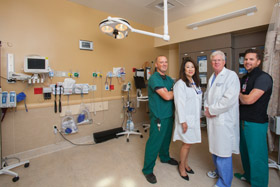 “We really are the go-to hospital for everything and anything,” says Allred. “Not only do we receive ambulance traffic with any severely injured trauma patient, we also receive quite a few transfers from some of the smaller, outlying hospitals in the five-county region [more than 2,000 per year]. So we provide a lot of service not just to the people in the immediate Santa Rosa area but the whole of Northern California. We also receive heart attack and stroke patients, and we’re the only hospital in town with in-patient pediatrics. We do position ourselves to be ready for anything and everything that can hit the front door.”
“We really are the go-to hospital for everything and anything,” says Allred. “Not only do we receive ambulance traffic with any severely injured trauma patient, we also receive quite a few transfers from some of the smaller, outlying hospitals in the five-county region [more than 2,000 per year]. So we provide a lot of service not just to the people in the immediate Santa Rosa area but the whole of Northern California. We also receive heart attack and stroke patients, and we’re the only hospital in town with in-patient pediatrics. We do position ourselves to be ready for anything and everything that can hit the front door.”A second factor requiring additional space is the increase in patients seen since Palm Drive Hospital in Sebastopol closed in June of this year. For many, Santa Rosa Memorial Hospital is the next-closest hospital for emergency care, and the emergency department has seen a significant surge in its daily volume.
Still another recent factor increasing volume in the emergency department has been an influx triggered by the Affordable Care Act (aka Obamacare) in the beginning of 2014. Hospitals across the country have seen a surge in newly insured patients, including many who lack a regular, primary care physician. SRMH has seen a 30 percent increase in volume from the same time period one year ago, starting around April 1, 2014. Average patient load has jumped from 100 to approximately 125 patients per day. All of these factors have converged to not only need more facility space and equipment, but added personnel as well.
“When Palm Drive Hospital closed, we saw a pretty significant surge in our daily volume,” says Allred. “Because of Obamacare, coupled with the fact that we have a bigger space and are absorbing a large number of patients who used to go to Palm Drive, we’ve expanded our physician coverage hours and our nursing coverage hours.” A new shift had already been added to accommodate higher patient volume in the summer of 2013. Now, an entire new shift will be added to the schedule during peak hours.
The bottom line: saving lives
While anyone can point to these factors (as well as simply the overall population of the county increasing yearly) as grounds for expanding our region’s primary trauma center, statistics show how truly critical it for the community.
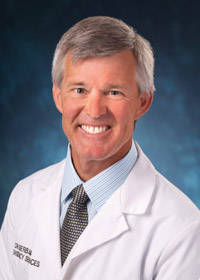 “I think it’s meaningful to the community at large because, before Memorial was a trauma center [SRMH was designated as the trauma center for Sonoma County in 2000], the preventable death rate for trauma in Sonoma County was 19 percent,” explains Tucker Bierbaum, M.D., medical director for St. Joseph Health’s Regional Referral Program and for the EMS Base Station at SRMH.
“I think it’s meaningful to the community at large because, before Memorial was a trauma center [SRMH was designated as the trauma center for Sonoma County in 2000], the preventable death rate for trauma in Sonoma County was 19 percent,” explains Tucker Bierbaum, M.D., medical director for St. Joseph Health’s Regional Referral Program and for the EMS Base Station at SRMH.“What that means is, if you had an injury we could save you from, we were able to save you about four out of five times. Twenty percent of the time, we lost you—‘we’ meaning not just Memorial Hospital but the health care system in Sonoma County. Since the advent of our trauma center at Memorial, the preventable death rate from trauma in the region is now less than 1 percent. So if you have a salvageable injury and you come to our trauma center, your life will be saved 99 out of 100 times. That’s a really meaningful statistic and that’s why you need to have a hospital like Memorial in the region.”
Bierbaum credits several factors for substantially decreasing the preventable death rate, including SRMH’s huge investment in resources. Most important is the investment in staff, such as board certified emergency physicians, trauma surgeons, experts in cardiovascular care and the neurosciences and more—all of whom are in the hospital or on call, 24 hours per day, seven days per week. An additional factor has been creating a system in the region among other hospitals and paramedics that directs appropriate patients, based on their condition and medical needs, to Memorial Hospital.
“Hospitals, at their core, are really there for people who don’t plan to go to the hospital,” says Bierbaum. “That’s why they ought to be built. They’re really there to meet unplanned, urgent needs. Elective knee surgery, elective cardiac surgery—those are easy to plan for. The hard part is to provide the unexpected and unanticipated critical care patients need. That’s what I’m most proud of: that Memorial has taken up the mantle of that responsibility. It’s there to provide the essential core of what a major hospital does.”
Show me the money
A condition the hospital can be particularly proud of is the remarkable amount of financial support it received from individual donors, family foundations and local businesses. Of the $15 million needed for the expansion, $11 million came from donors’ support.
“The best part of this campaign was educating those who didn’t understand what it means to have this level of care so close to home,” says Andrea Learned, vice president of development for St. Joseph Health in Sonoma County, which includes Santa Rosa Memorial Hospital Foundation. “It means the world to families and patients to have exceptional care when surprising and life-threatening accidents or medical crises strike, such as a stroke or heart attack. We’re grateful for every commitment donors made to support this important project.”
Even the Wright Family—the family of the general contracting company overseeing the renovation project—made an extraordinary gift of funds. In addition, it helped create beautiful art in the emergency department’s new garden in memory of Peggy Wright, who was an original “Rose Lady”—a name formerly bestowed on many of the hospital volunteers.
“It’s remarkable to note that we received 5,750 gifts for this campaign,” says Learned. “We live in a community that cares, where people are willing to work hard to make this one of the healthiest communities in the United States. We’re proud to have a legacy of making sure everyone is welcome here and that every person is treated with compassion.”
Will it be enough?
McCalla, with his love of analogies, offers up this comparison when asked about whether the expansion will be enough to meet rising demand—at least in the immediate future.
“The physical space of the emergency department is just the infrastructure where we take care of patients, much like the freeway is the infrastructure that helps cars and people move around,” he says. “The freeway gets widened when it gets really busy and, once you get done with construction, it’s almost time to add another lane because it’s busier still.”
With the various recent factors increasing patient volume, in addition to normal population growth, it’s almost time to “add another lane” already. Yet the North Bay can feel fortunate and proud of having such a high-level, state-of-the-art trauma center with excellent physicians and staff. Going through this renovation together has only strengthened and bonded the team to act in congruence—whatever may hit the front door.
The Vote Is In
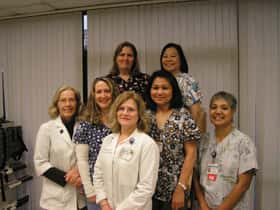 Besides renovating and expanding Santa Rosa Memorial Hospital’s emergency department, another recent newsworthy item has also caused St. Joseph Health, which operates Santa Rosa Memorial Hospital (SRMH), Petaluma Valley Hospital and Queen of the Valley Medical Center in Napa, to receive positive press. Namely, both SRMH and Queen of the Valley Medical Center have been recognized for back-to-back years (2013 and 2014) by the Women’s Choice Award as being among America’s best hospitals for orthopedics. The award is based on robust criteria that include patient satisfaction measurements as well as consideration of areas of clinical excellence. Both hospitals have also been named Blue Distinction Centers for knee and hip replacement by Blue Shield of California.
Besides renovating and expanding Santa Rosa Memorial Hospital’s emergency department, another recent newsworthy item has also caused St. Joseph Health, which operates Santa Rosa Memorial Hospital (SRMH), Petaluma Valley Hospital and Queen of the Valley Medical Center in Napa, to receive positive press. Namely, both SRMH and Queen of the Valley Medical Center have been recognized for back-to-back years (2013 and 2014) by the Women’s Choice Award as being among America’s best hospitals for orthopedics. The award is based on robust criteria that include patient satisfaction measurements as well as consideration of areas of clinical excellence. Both hospitals have also been named Blue Distinction Centers for knee and hip replacement by Blue Shield of California.While the Women’s Choice award came as a surprise to administrators and staff (this wasn’t something they’d applied for), it certainly wasn’t a surprise that patients chose them as the best, given their continual research on best practices; commitment to personalized care; aggressive approach on pain management, physical therapy, and patient education; and, moving forward, an expanding focus on health (including wellness and keeping patients out of the hospital when possible).
“Of course, at the hospital, we’re still focusing on doing successful surgeries,” says Courtney Hurwitz, service line manager for the Orthopedic Department at SRMH, “but with the movement toward keeping individuals healthy and out of the hospital, we’ll also be focusing on a health restoration-type program.”
With an RN who serves patients as their dedicated orthopedic navigator, the hospital provides comprehensive pre- and postoperative education for patients (including free total joint classes) to help them understand their options and get them back to mobility as soon as possible.
“We’re pushing more toward a hospital center of care where issues are addressed long before patients need surgery, to promote an active, healthy lifestyle,” says Michael Star, M.D., chairman of Orthopedic Surgery at SRMH. “That can either avoid the need for surgery or, if they have surgery, the results will be better.”
Other factors that physicians and staff believe set them apart is the high quality and dedication of their staff, and the way the hospital has embraced the hospitality aspect of care, implementing single, private rooms (as of August 1, 2013) and adding other small patient amenities to help make the experience positive such as better food, wine service and premium coffee.
“It’s a stressful time for patients,” says Star. “Orthopedics is different in that you’re not coming into the hospital because you’re sick. You’re coming in to actually get better. We try to make it a positive experience because this is your first step to getting back to mobility. It’s a different mindset than other parts of the hospital where you come in when you’re really sick. We treat our patients like we want to be treated ourselves.”
One feature that’s been very successful at the orthopedic department at Queen of the Valley Medical Center, a designated premium facility for total joint replacement by United Healthcare, has been its “total joint program.” This program was developed in conjunction with surgeons, the physical therapy and occupational therapy departments, the nurse manager and staff in the surgery, registration and preadmission units. The team looked at the pathway of the patient and the requirements of each step in the process, which culminated in a “total joint book” and class being developed to help patients get ready for surgery and know what to expect at each phase of the process.
“People who know what to expect do much better with surgery,” explains JoAnn Munski, director of Ortho/Neuro/Rehab Services at Queen of the Valley Medical Center. “They know how to plan things. Part of this multidisciplinary team getting together was developing a common language and expectations [between departments and for the sake of patients’ understanding].
This focus on the patient has positively benefited every aspect of the orthopedic department, but most significantly, the patients themselves. The average hospital stay (post orthopedic surgery) dropped from almost four and one-half days to less than three. That’s good news, for even with the best, award-winning orthopedic department, most patients would agree that being home is still the preferred choice.


